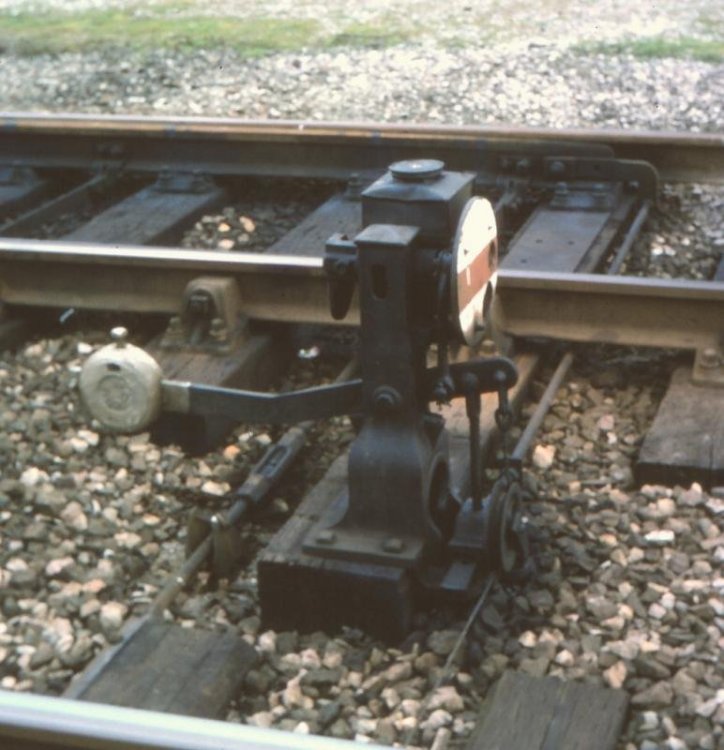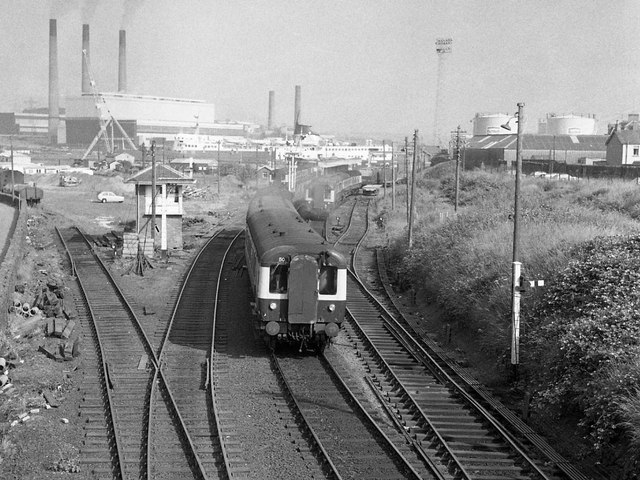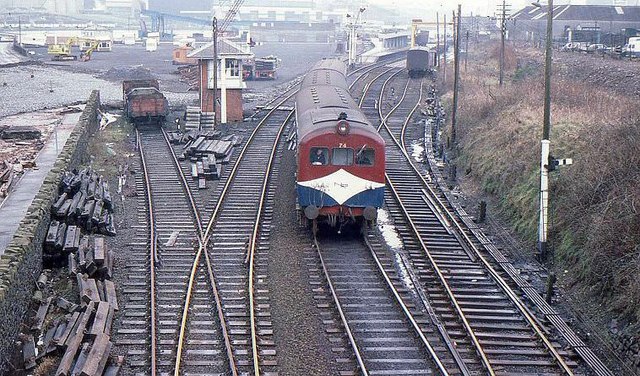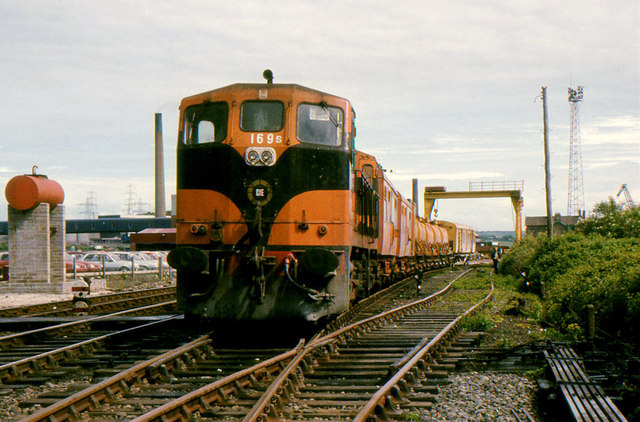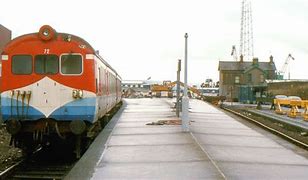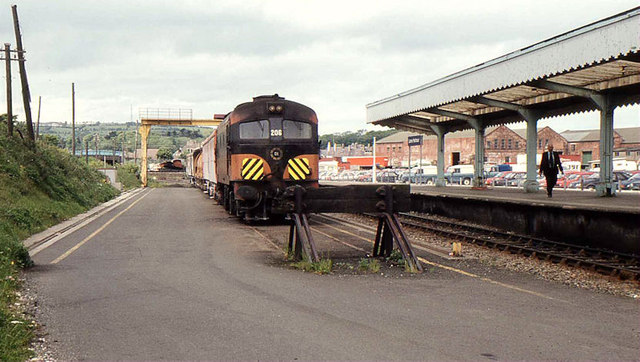-
Posts
228 -
Joined
-
Last visited
-
Days Won
1
Content Type
Profiles
Forums
Events
Gallery
Blogs
Store
Community Map
Everything posted by LARNE CABIN
-
And now for something completely different, as they say. At the harbour I have recently been focusing my attention on ground signals. In 1969 there were eight ground signals still in place at the harbour. I will include five of these on my layout. Omitted is the signal linked to Lever 26 which controlled exit from the minor harbour sidings to the Down Main Harbour Siding line, which was connected to the Down Main Line, and I have lifted these ridings ie. no room for them. Also ommitted is the double stacked signal linked to Lever 16 which controlled entry to the Down Main Harbour Siding. This is omitted because although the Down Main Harbour Siding is still in place in 1969, it is about to be lifted (and I only have room for the start of this siding). For 4mm modelling there is very little available, mainly the Ratio 465 plastic kit and the MSE fret. The Ratio kit is decidedly GWR. The lamp and back blinder are totally wrong for the LMS! I have built up two Ratio signals and adapted them as much as possible, but very difficult in such a small scale! This is the signal controlled by Lever 17 which controls exit from the Down Harbour Road Siding, which runs behind the Signal Cabin, out unto the Down Running Line. This is the signal controlled by Lever 18 which controls exit from the Up Long Siding and eventually out unto the Up Running Line via the Upper Quadrant Shunting Signal controlled by Lever 20. Lever 18 controls two ground signals, this one, and another for the Up Short Siding with buffer stop. Two discs controlled by the one lever, so some more research to be carried out there! Perhaps half pull and full pull! We'll see. I have cut out and glued on the little triangular back blinder to make it look more LMS prototypical. To be honest, I am not really too happy with these. They're not up to the standard I like to attain, so I'll probably use this as a learning curve and start again using the MSE fret. This leaves the double stack ground signal almost in front of the Signal Cabin. This signal is controlled by Lever 22 and controls access to the two platform roads. The top disc controls access to the line on the left, ie. Platform 2, the former Narrow Gauge Platform and the bottom disc controls access to the line going straight on, ie. Platform 1, the main and long platform. I have decided to put a lot of effort into this one and build it as carefully as possible and provide for a future working disc signal. This causes an authenticity problem though. Larne Harbour was resignalled by the LMS in 1932/33, so the ground signals are most likely, and look like, the older type, but it's stated that the older type LMS Ground Signal dates from 1934! In order to have any chance of a working signal I have decided to use poetic licence and use the standard 1941 LMS ground signal as produced by MSE, and also this handy little fret produced by Palatine Models. The discs on this are particularly good. Any working stacked discs I've seen are made from the 1941 pattern. This is an extract from Michael H C Baker 's photo in Irish Railways Past and Present showing the double stacked disc signal controlled by Lever 22. The signal at the top left is the exit single from the minor harbour ridings omitted on my layout and the signal bottom right is the exit signal for the Long Up Harbour Siding, modelled above. This photo, courtesy of RMweb Permanent Way, Signalling and Infrastructure gives an enormous amount of clear detail on the 1934 LMS. So more a learning process here than actual progress. That's enough for ground signals for now! Some more point rodding has been delivered to the harbour, so it's back to that now. Something that looked very difficult a few months ago now seems very simple compared to working signals!
-
Time for some more work on the canopy. As mentioned in a previous post, the photo in Ian McLarnon Sinclair's Along UTA Lines (courtesy Station UK 29829) has been used as the best available end-on view. I've made a sketch from that and then modeled using Plastikard and 1.5mm x 0.5mm Plastruct Styrene Strips. I've used 5mm, 6mm and 7mm strips to model the pattern as close as possible. The long platform section has 125 strips! This is the valence now added to the stantions and the rear corrugated roof added. I have not put in the roof on the front section yet, as I am hoping to include some translucent corrugated strips. This photograph is by Des Fitzgerald and is produced in Derek Young's The Ulster Transport Authority in Colour. As mentioned before, it has given me a lot of detail about the platform face and the state of the trackbed in the platform area and also helps a lot in proportioning a model in limited space. For example, a 46 foot Jeep will sit between the start of the platform ramp and the Swan Neck Lamp and then the distance between the Swan Neck Lamp and the Station Nameboard etc., so it allows me to realistically model the start and give some perception of a very long platform........ ........... and so this is my version, so far. Gaugemaster GM816/819 is an almost identical version of the Swan Neck Lamp, but very difficult to source at the moment. I have a rake of UTA carriages so all that is missing is the Jeeps. Just waiting on IRM!
-
Absolutely brilliant Noel. So realistic and so inspirational for anyone working towards modelling an actual location. Just love your updates.
-
Thanks to @Galteemore and @Georgeconna for advice. I have looked up Archimedes and think I will give that a go. Also thanks to @Si2020 for very useful info. Very helpful.
-
Hi all, I am seeking advice on the most appropriate mini drill. I purchased a small hand drill, but failed miserably when I tried to drill a 0.5mm hole in a resin kit! The bit snapped immediately. I need something suitable for working with resin kits and also brass etch such as MSE Signal Kits where I would need to drill cast whitemetal posts. Any advice greatly appreciate.
-
Thanks @murphaph and @Galteemore for your encouraging comments. The long term plan is that the points will work to allow for some shunting within the confines of the station area and provide some operational interest. For example, as mentioned above a few times, shunting some Brown Vans or the ex GNRI Parcels Van into the Short Up Siding for unloading of mail bags for Stranraer. I plan to build the Upper Quadrant Semaphore Signals as accurately as possible (have already started building from MSE parts). Larne Harbour was the only installation of Upper Quadrant Semaphore Signals in Ireland, so a unique signature feature! At the moment, I think 'working' would be beyond me, but we'll see how it goes! There will be three sets of semaphores, so maybe I will be able to achieve one working and there will be a number of Ground Signals, the most prominent being a double one just in front of the cabin, controlling shunting into the platform roads, so I may attempt to get that one working.
-
The Signal and Telegraph Gang have been working on the six rod run for a few weeks now. The run is being assembled in two sets of three rods each. The first set being assembled is the set furthest from the running rails. Looking down from the bridge on the Olderfleet Road gives a good impression of what has been achieved so far. The set being assembled has already been connected to the associated levers in the cabin. The cranks are arranged at different heights to prevent any one rod from fouling any other. The rod furthest from the running rails is connected to Lever 21, which controls the point giving access to the Short Up Siding with buffer stop (yet to be included). The next rod is connected to Lever 19, which controls the point giving access to the Longer Up Siding (which extends beyond the scope of the layout) and hence to the Short Up Siding and the final rod of the three, as far as I can ascertain, connects to Lever 6, which gives access to the siding behind the Signal Box which runs along parallel to Harbour Road. All photos are my own (no copyright necessary). ............ the gang have to wait now on more rodding being delivered to the harbour, so will probably move on to something else, maybe a wee bit less labour intensive. I'm hoping maybe a few ground signals or maybe some work on the platform canopy, more soon ................
- 203 replies
-
- 15
-

-

-
I have already replied to the above in DJ Dangerous's thread 'Why Do People Remove Photographer's Watermarks' in the 'Letting Off Steam' Forum, but to reiterate, thanks to @DJ Dangerous for defending me and sincere apologies to @Jonathan Allen. I did not and have not removed a photographer's copyright watermark from any photographs. In the above instance I copied the photo from a general images website, not Flicker, unaware that I was infringing any copyright. I always try to acknowledge photographers and indeed on my Larne Harbour Station thread have referred to photographs in various books which have been helpful to me in his project, and there are many brilliant photographs out there. So again please accept my sincere apologies.
-

Why Do People Remove Photographers' Watermarks
LARNE CABIN replied to DJ Dangerous's topic in Letting off Steam
Thanks to @DJ Dangerous for defending me and sincere apologies to @Jonathan Allen . I did not, and have not removed copyright from any photos, but as @DJ Dangerous says picked it up from the internet unaware of any copyright, so please accept my apologies. -

LARNE CABIN'S GNR(I) P2 Parcel Van Workbench
LARNE CABIN replied to LARNE CABIN's topic in Workbench
A little more progress on the 'P' Van. Reverse side completed and glued in, doors attached, bogies partially complete and more paint experiments! After much experimenting with various browns, have finally decided on this brown/red which is Humbrol 160 German Camouflage Red/Brown. Still to complete windows, vents, valence over doors, bogies, couplings, buffers, vacumn pipes, brake wheel, numbering, mail bags piled at open door and probably much more, so probably just over half way there! A glimpse of the end game, being shunted to a siding at Larne Harbour for unloading of mail bags for Stranraer Ferry. Oops.......... hadn't noticed that bogie until I had posted the picture......bogies not properly attached yet! -
Time to get this thread back on track , excuse the pun. I have been working on point rodding at the harbour over the last few weeks. I started off with a single lever and rod, the only rod which turns left from the box. The crossover between the two platform roads is controlled by lever 24 and one single rod. At first, I found this hard to understand, as I am no expert in such matters, but a bit of research explained that this was achieved by means of a 'drop lug' which allowed a rod to come off the main rod to the point blade nearest the signal box while the main rod continued to the point blade furthest from the signal box thus operating both points from the one rod and lever. As this single rod is quite long (over 200 scale feet), a compensator is required. Point rodding expands on warm days and to prevent this from causing a problem to the finely tuned mechanisms the amount of 'push' movement in the rod must equal the amount of 'pull' movement so that the expansion counteracts itself. The compensator is required in the middle of the run to convert half of the rod from 'push' to 'pull', or vice versa. There are many photos up to late 1969 showing this long run arrangement to control the crossover. I found the one on page 122 of Michael H C Baker's Irish Railways Past and Present, September 1969, very useful and informative, but when the turnout to the goods yard and harbour was lifted the rodding took the shorter more direct route on the signal box side of the tracks, straight to the crossover. This photo, 12th July 1977, shows the rodding on the more direct route...... and again this 1980 photo. The gang have gone off for lunch, so I was able to get this shot of rodding being assembled for the six rod run towards the bridge. This is being assembled in two groups of three rods each. The six rod run will be a bit of a challenge, but I am into it now! There are many photos showing the six rod run, but this 1985 photo gives a fairly clear view of the start of the run. Very useful to me. Please note that no ballast will be laid until the point rodding is complete and that the colouring at the moment is purely first basic background colouring!
- 203 replies
-
- 11
-

-

-

Brookhall Mill - A GNR(I) Micro Layout
LARNE CABIN replied to Patrick Davey's topic in Irish Model Layouts
Just gets better and better Patrick. It is so refreshing to see a layout like this develope, mostly all scratch built, such fine detail and so, so realistic! Truely inspirational. -
https://www.bbc.co.uk/news/uk-northern-Ireland-57062856
-
It's on the 'For Sale or Wanted' thread, Saturday 12:18 and Friday 23:35!
-
Hi Jim, @airfixfan, thanks for that! It's funny how you, (meaning me), can be so blind to the obvious! I made a statement above about being undecided about the livery that I would eventually apply to my 70 Class set. I have so many photos, but it was only when you made the above comment that I realised that the Worsley Works etch I am using is the standard window setup and that the Sealink Set is the hopper window setup. So that is my decision made for me, the 70 Class livery for Larne Harbour will be the original Oyster Grey and Maroon. The Sealink Livery is still my favourite though!
-

Brookhall Mill - A GNR(I) Micro Layout
LARNE CABIN replied to Patrick Davey's topic in Irish Model Layouts
So I take it that the 121's are there to haul some of those GN Linen Vans down south, via Lisburn! Got it now. -

Brookhall Mill - A GNR(I) Micro Layout
LARNE CABIN replied to Patrick Davey's topic in Irish Model Layouts
Looks wonderful Patrick. Ouses GNRI atmosphere! Love the AEC set and the GNRI Home Signal, but what are those two ,121's doing at Brookhall Mill? How did they get there? -
February 1985, the canopy has gone, just the NIR Station Nameboard and the stump of the swan neck lamp left! I have included this photo for three reasons: 1) The platform surface, sections of smooth concrete, with coping stones a darker grey, a bit shiny in the wet, as per my model of the platform above 2) The house in the right background. Outside the area of my model, but to be included, either in low relief on a backscene, or painted on a backscene to give perspective and distance 3) The Sealink Livery on 72 River Foyle, intermediate 725 and driving trailer 701, you either love it or you hate it! There's a photo by Denis Grimshaw in Jonathan Allen's 35 Years of NIR and the caption reads "Perhaps the most outlandish livery applied to any Irish railway vehicle"! I love it! It's probably my favorite livery. I have a Worsley Works etch and doner coaches for a 70 Class Set which I have started working on. It's a long term project, but once I get to painting in a few years time, my original intention was the original Oyster Grey and Maroon so that my 70 Class could arrive at my Larne Harbour Station in 1969/1970, but I may be sorely tempted to go for the Sealink Livery and just have it on display!
-
Hi Robert. When I first saw 'Carrick Station' on the Model Layouts thread, my heart raced, as I thought great, another Larne Line NCC/UTA Station, Carrickfergus! But, alas no! Plan looks great, and I am envious of such space. Will be watching progress on this. Enjoy.
-
Just as a little aside, and a break from Signal Box, Point Rodding, Platform etc., have built up a few LMS Platform Seats from Dart Castings. These folk are waiting on a train for York Road..........they will have a long wait by the look of things, but eventually one will come along!
-
Thanks Jim, @airfixfan, for that first black and white photo of the Olderfleet. I have never seen that one before. Yes, @Galteemore, the side on Fleet Street is basically still there but now very modernised. A lot of money has been spent on it over the past year or so! It is now called The Olderfleet Bar and Garden Venue. It will have a large outdoor garden area and they are obviously anxiously awaiting the Covid restrictions to be eased so that they can get up and running again!
-
Yes, I have that one. Was also going to include this 1981 picture, with River Bush. Shows a lot of detail of the canopy!
-
Very slow progress at Larne Harbour Station, but some work on the platform recently. My guide for the platform is the photo by Des Fitzgerald on page 79 of Derek Young's book The Ulster Transport Authority in colour. The platform surface is sections of smooth concrete with the coping stones a darker grey. The platform face is smooth concrete with patches of black from soot, coal dust etc. I think I have captured the perspective, suggesting that is the start of a long platform, for example, in the photo a jeep, 46 feet, will sit between the start of the platform ramp and the swan neck lamp!, (just a hole in the platform at the moment). The canopy at Larne Harbour seems to be unique, and again hoping to achieve authenticity, I want to copy it as exactly as possible. I used the picture on page 166 of Ian McLarnon Smith's Along UTA Lines to measure and count the slots on the side end of the canopy. This will be made using Plastruct Styrene Strips cut to three lengths to create the valance, so lots of painstaking work ahead. The photo below is from June 1983, and shows the canopy, in a fairly dilapidated state, prior to its removal as part of the rebuilding in 1984/85.
-
Hi Ian. I agree with David and Jonathan's comments above. As 'Trathnona' is 6ft by 10 inches, surely it can fit in along one wall and enhance the home office! It's really amazing what you can accommodate in a small space. The Larne Harbour Station layout I am working on is 6ft by 20 inches and will sit in an alcove in a home office type room. Save 'Trathnona'!
.png.c363cdf5c3fb7955cd92a55eb6dbbae0.png)

